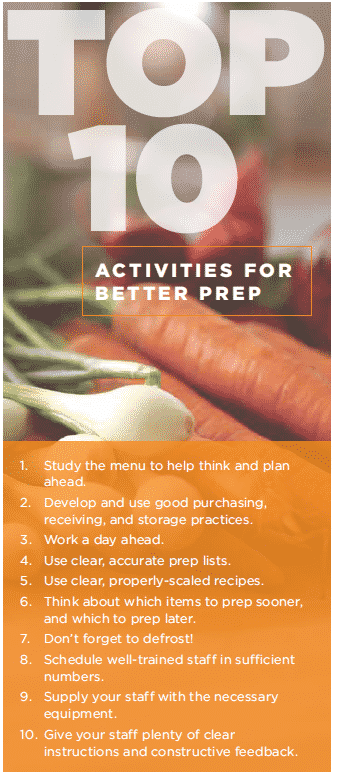 Improving your kitchen operations from the prep work up.
Improving your kitchen operations from the prep work up.
Every day more communities are making a commitment to improve the quality and variety of the food they serve their residents. This process may include making a number of changes to basic operations. Menus, recipes, ingredients, equipment, staff, systems and procedures, schedules and budgets might all benefit from some scrutiny. In our quest to improve our residents’ experience, one of the simplest, most cost-effective things we can do is improve the quality and efficiency of our kitchen staff’s prep work. And with all the special events and menus we’ll produce during the Holidays, this is an especially good time to give prep work some extra thought. Let’s take a look at a few things we can do to improve the way we prep.
Start with the Menu
Prep work is totally menu-driven. One of the most important parts of your job as a chef or kitchen manager is to be completely familiar with the menu and how to produce every item on it. This will tell you everything you need to know to lay the groundwork for successful, efficient prep: having enough of all the ingredients you’ll need when you need them, having enough staff scheduled, having the necessary equipment available, and being able to direct the actual production.
Purchasing, Receiving, Storage and Inventory
Even the spunkiest crew led by the most inspired chef can’t produce a menu without the correct ingredients in sufficient quantities available when they need them. This is accomplished through good purchasing, receiving, storage and inventory practices.
Accurate purchasing insures that you’ve ordered the correct amounts of everything you need; good receiving practices makes sure that those items get delivered in good condition; and proper storage avoids waste through spoilage and theft while making it easy to find product and do inventories. Inventories, both monthly and quick spot-checks done before placing orders, help everyone involved know exactly what’s in-house.
(More detailed information on this can be found in the May/June issue of Edge, in the article Controlling Food Costs.)
Clear Prep Lists and Recipes
Now that you’ve got all the correct product in house, you need to make sure everything that needs to be done to those products gets done. Depending on the size and complexity of your operation, a combination of prep lists and recipes will be the best tools to accomplish this. Prep lists are very useful if you divide up the labor in your kitchen between different types of prep, instead of just by recipe. In larger situations, for instance, you may assign one person to do all the vegetable prep for all the recipes. Those prepped items are then given to the stations that will use them to complete their recipes, such as soups, vegetables, entrées or starches. The prep lists should include all pertinent information to lessen the chance of any confusion. Specify the exact item (random chicken breasts or 6-ounce?); the weight, volume, or number and size of portions required; the station that will use it; whether they should talk to you about it before they start; the name of a preferred cook; and anything else they need to know to do the right thing.
Recipes should be clear, easy to read and scaled to the correct number of portions. A grease-stained recipe with the second page missing, written for 6 portions when you want 85, is probably not going to result in anything anyone will be proud of. A short chat with whoever will be making a dish, whether to say how great it was the last time they made it, or that is was too salty, or to give advice about a tricky procedure, is time well-spent.
Timing is Important
Think through your menu and decide when certain items should be prepped. Working ahead a day is great and should be your goal. Not only will you sleep better, but when something goes wrong – and you know it will – it’s better to have 24 hours to fix it than 24 minutes. Some items, like stews, will actually improve with a little age and should be prepped a day or two before you need them (stored properly, of course.) Other items, like steamed broccoli, should be cooked at the very last minute – although you can weigh and trim it earlier that day.
One of the main things that can cause an otherwise great prep day to go south is a product you need to butcher and cook that’s frozen solid. The same way a roast may need two hours to cook – and if you don’t get it in the oven soon enough you’re in trouble – a case of chicken might need two days to thaw in your cooler. Think ahead! When looking over your weekly menus, be especially aware of things that need time to thaw, and make sure it gets done.
Staff
Once you’ve studied your menu and scaled recipes and written your prep lists, you’ll see exactly what needs to be done. Use this insight to schedule the right amount of qualified staff, including stewards, to get the prep done without either wasting money on excess staff or prepping raw vegetables as your residents are walking into the dining room. I know this is easier said than done for a lot or reasons. If it ends up being impossible, it might be time to adjust your menus, find more-capable staff, or talk to your director about increasing your budget. None of these options is painless but, in the interest of the quality of your product, could be necessary.
Allow extra time for special Holiday prep. It’s hard to really know how much time or effort special menu items will require. Err on the side of caution. If you need more hands on deck and are able to schedule it, that’s great. Just be aware of their skill level and have as much supervision available as is actually needed.
The Right Tools
Don’t underestimate the importance of providing your staff with the tools they need to get their jobs done. You should understand exactly what equipment it takes to produce the prep you’re asking your staff to produce. Supplying the necessary containers, pots, ladles, side towels, china, functioning ovens and other “small” things make the difference between great prep done by a happy crew and the opposite. Don’t frustrate your crew and undermine their performance by scrimping on basic equipment.
Keep an Eye on Things
Last but not least, your crew needs – and wants – clear direction from managers, along with attentive follow-up. Show your staff exactly what you want them to do, how you want them to do it, and what an acceptable pace is. Don’t expect them to get it right the first time, and don’t assume that if they did it perfectly yesterday, they’ll do it perfectly today.
Take frequent laps around the kitchen to see what everyone is doing. As a manager, you can’t pay too much attention. Gently coax, courteously correct and praise as is appropriate. Sauces should taste good, grilled items shouldn’t look poached, 4-ounce portions should be 4 ounces, and good sanitation should always be practiced. Don’t take anything for granted, keep standards high, and never miss a chance to tell someone you love what they’re doing.
